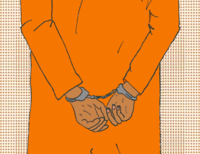New data reveals where people in Delaware prisons come from
Report shows every community is harmed by mass incarceration
September 15, 2022
Today the Prison Policy Initiative, along with Delaware advocates Kyra Hoffner and Jack Young released a new report, Where people in prison come from: The geography of mass incarceration in Delaware, that provides an in-depth look at where people incarcerated in Delaware state prisons come from. The report also provides six detailed data tables that serve as a foundation for advocates, organizers, policymakers, data journalists, academics and others to analyze how incarceration relates to other factors of community well-being.
The data and report are made possible by the state’s landmark 2010 law that requires that people in state prisons be counted as residents of their hometown rather than in cells when state and local governments redistrict every ten years.
The report shows:
- All three counties — and every state legislative district — are missing a portion of their population to incarceration in state prison.
- Wilmington has the dubious distinction of having both the highest number of city residents incarcerated as well as the highest incarceration rate of any city in the state.
- Mass incarceration is not just a problem impacting large cities. Many smaller towns are also hit hard. Laurel, for example, has an incarceration rate of 1,227 per 100,000 residents, while Blades has a rate of 924 per 100,000 residents.
Data tables included in the report provide residence information for people in Delaware state prisons at the time of the 2020 Census, offering the clearest look ever at which communities are most impacted by mass incarceration. They break down the number of people locked up by county, city, zip code, legislative district, and census tract.
The data show the cities with the highest incarceration rates are Wilmington (1,299 per 100,000 residents), Seaford (748 per 100,000 residents) and Dover (680 per 100,000 residents). For comparison, Newark has the lowest incarceration rate of any city, at 131 per 100,000 residents, nearly ten times lower than Wilmington, and nearly three times lower than the state rate of 380 per 100,000 residents.

“The nation’s 40-year failed experiment with mass incarceration harms each and every one of us. This analysis shows that while some communities are disproportionately impacted by this failed policy, nobody escapes the damage it causes,” said Emily Widra, Senior Research Analyst at the Prison Policy Initiative and co-author of the report. “Our report is just the beginning. We’re making this data available so others can further examine how geographic incarceration trends correlate with other problems communities face.”
The report cites studies that show that incarceration rates correlate with a variety of negative outcomes, including higher rates of asthma, depression, lower standardized test scores, reduced life expectancy and more. The data included in this report gives researchers the tools they need to better understand how these correlations play out in Delaware.
“This report provides the most precise picture ever of which communities are most impacted, and just as importantly, it shows where support and resources should be deployed to repair that harm,” said Kyra Hoffner, co-author of the report.
“Every person locked behind bars in Delaware represents a piece of the fabric of a community that is missing,” said Jack Young, co-author of the report. “This report and data provide critical guidance on where and how resources and support should be allocated.”
The report is part of a series of reports examining the geography of mass incarceration in America.
Delaware is one of more than a dozen states and 200 local governments that have addressed the practice of “prison gerrymandering,” which gives disproportional political clout to state and local districts that contain prisons at the expense of all of the other areas of the state. In total, roughly half the country now lives in a place that has taken action to address prison gerrymandering.



